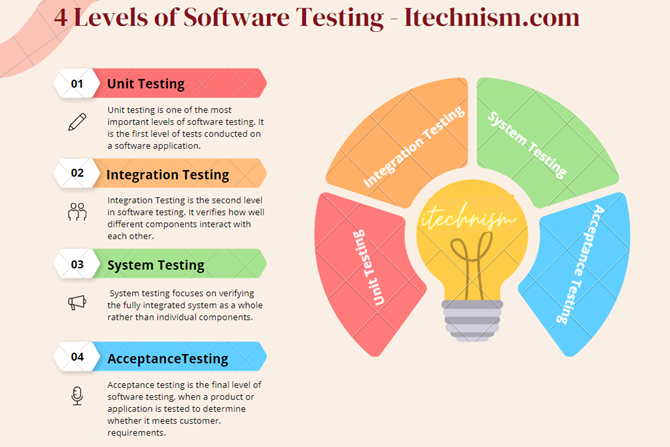In software testing, there are 4 levels of software testing? In this article, we will explore what these levels are and how they can help improve the quality of your software product. Following are the different levels of software testing in software engineering:
- Unit Testing
- Integration Testing
- System Testing
- Acceptance Testing

Unit Testing – 1st Level of Software Testing
Unit testing is one of the most important levels of software testing. It is the first level of tests conducted on a software application to ensure that all individual components and functions are working as expected. Unit tests are carried out by developers, with the goal of isolating each part of the program and determining whether it behaves as expected.
Unit testing is a form of white box testing, meaning it focuses on internal structure rather than external behavior. During unit tests, developers typically write code that interacts with the code they have written to check for errors in logic or functionality. This process helps identify bugs early and ensures higher quality overall product delivery. Furthermore, running unit tests frequently during development can help reduce debugging time down the line and increase efficiency in development cycles.
Integration Testing – 2nd Level of Software Testing
Integration Testing is one of the most important levels in software testing. It verifies how well different components interact with each other and whether they work together as expected. During this level, integrated components are tested as a group while still allowing for individual component tests to be conducted. Integration Testing works to make sure that all the parts of a system can be integrated into a whole and that data exchange between the various parts is successful. This type of testing ensures that all the separate units behave correctly when combined together and thus contributes towards making sure the overall system meets its requirements and objectives.
The following are the main approaches or methods used when carrying out integration testing:
- The Big bang integration testing is one of the most important approaches to performing integration testing. It helps ensure that newly developed components and features are compatible with the existing software architecture and codebase. Big Bang Integration Testing requires putting all the components, modules, and sub-systems together and being tested at once as a whole. This type of integration tests how well different modules work together when combined into a single system, providing users with a comprehensive view of all potential issues prior to deployment. This method works well for small systems but can be difficult to manage in larger systems with lots of components.
- The Incremental Approach is a method of integration testing, which involves integrating two modules and then testing them, once these modules are tested successfully other modules are integrated for further integration testing. It also allows developers to track progress easily by managing small components separately rather than dealing with a large system all at once. Using an incremental approach helps reduce risks associated with complex software development projects.
- In top-down integration testing, the highest level of the module of an application is tested first. It involves testing the higher-level modules first and then progressively moving down to lower levels for each successive test. Performing this type of test helps identify any potential problems before further tests are conducted at lower levels because all interactions between modules have been tested and verified from top to bottom. A failure at a lower level means that there may be an issue with one or more components at a higher level. Top-down integration testing ensures that each layer works together efficiently so that errors can be identified and fixed quickly.
- The bottom-up integration involves the testing of the lowest module in a system first and gradually working up to higher-level modules. This approach can be useful for identifying coding errors, as well as any inconsistencies between different parts of the system. It also ensures that individual modules are able to interact correctly with one another and perform their intended functions properly when integrated into a larger whole.
- Hybrid integration testing combines both bottom-up and top-down integration testing. Hybrid integration testing is an advanced strategy that combines two popular testing processes: bottom-up and top-down integration tests. The goal is to get the mid-module by testing both the top and bottom modules simultaneously. This approach also called sandwiched or mixed integration testing which uses stubs and drivers.
- Stubs and drivers are dummy programs that simulate real code components within a program, allowing developers to test how parts of a system interact with each other without having to build them from scratch every time in place of modules that are not available, not developed, or missing so that tests can be run on a module before its dependencies have been built.
SystemTesting – 3rd Level of Software Testing
System testing is an important level of software testing that ensures the quality, reliability, and performance of a program or application. It assesses whether the system meets the requirements specified in its design by simulating real-world scenarios. System testing focuses on verifying the fully integrated system as a whole rather than individual components, making it an effective way to uncover any major issues before deploying the software. The test cases are written against use cases and business requirements defined in software design documents.
System testing can be divided into three main parts: functional testing, load testing, and stress testing. Functional tests verify that all features are working correctly according to their specifications. Load tests measure how well the system performs under heavy workloads while stress tests check how well it handles unexpected inputs or extreme conditions.
Acceptance Testing – 4th Level of Software Testing
Acceptance testing is the final level of software testing, when a product or application is tested to determine whether it meets customer requirements. Acceptance testing should be performed after unit, integration and system tests have been conducted to ensure that all functions are operating correctly. This level of testing primarily focuses on verifying whether the software correctly meets customer requirements and specifications.
It is generally performed by customers or testers that are not part of the development team to ensure impartiality in testing. Tests during this level of testing should include installation tests, compatibility tests, volume tests, performance tests and usability tests. In addition to ensuring that customer requirements are met, acceptance testing also helps identify any potential issues before release to production. The results from this stage will indicate if the system is ready for deployment or needs further refinement prior to launch.












